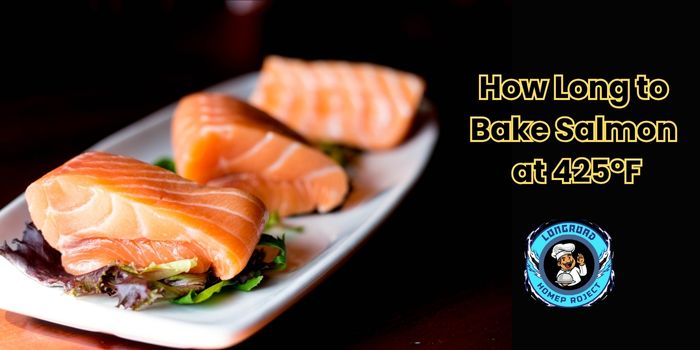As an Amazon Associate I earn from qualifying purchases.
Ever pulled salmon out of the oven only to find it overcooked or underdone? You’re not alone—and knowing exactly how long to bake salmon at 425°F can be the key to finally getting it right. Whether you’re cooking skin-on, skinless, wrapped in foil, or even from frozen, the right timing changes everything.
The first time I baked salmon at 425°F, I followed a basic recipe without thinking much about thickness or whether I should cover it. The result? Dry on the outside, undercooked in the center. It was a frustrating reminder that salmon—while simple on paper—is all about precision and feel in the oven.
This complete guide is here to help you avoid those mistakes. You’ll learn:
- ✅ The ideal baking times for salmon at 425°F depending on size, skin, foil, and more
- ✅ Whether 400°F or 425°F is better for your cooking style
- ✅ Expert tips for juicy, flaky results (without overcooking!)
- ✅ Real answers to common salmon questions (including what Reddit says)
- ✅ And how to tweak cook time for frozen, skinless, or thick fillets
So whether you’re meal-prepping, cooking dinner for the family, or impressing guests, this post will guide you to salmon that’s flaky, moist, and perfectly cooked—every single time.
So, How Long Should You Bake Salmon at 425°F?
Salmon typically takes 10–12 minutes to bake at 425°F, depending on the thickness of the fillet. This high-heat method helps lock in moisture and creates a lightly crisped exterior without drying out the inside.
A reliable general rule is to bake salmon for 4–6 minutes per ½ inch of thickness at 425°F. That means:
- A thin 1-inch fillet = ~8–12 minutes
- A thick center-cut piece (1.5 inches or more) = closer to 14–16 minutes
Internal Temp for Perfect Doneness
While time is important, the most accurate way to know when your salmon is done is to check the internal temperature using a meat thermometer. For salmon cooked to medium, aim for:
- Internal Temp: 125°F–130°F
- Remove from oven at 125°F, as it will continue to cook slightly while resting
Some prefer salmon slightly rarer (120°F), especially when cooking sushi-grade or wild-caught fish. If you want a firmer texture or well-done result, cook to 135°F—but avoid going above 140°F, as it dries out quickly beyond that point.
How to Tell If Salmon Is Done Without a Thermometer
If you don’t have a thermometer on hand, rely on these simple visual cues:
- Flakes easily with a fork
- Opaque rather than translucent in the center
- Juices run clear (not milky or white albumin-heavy)
- A slight separation between the layers of the fillet
Pro Tip: Use the back of a fork to gently press the thickest part—if it flakes apart cleanly, it’s ready.
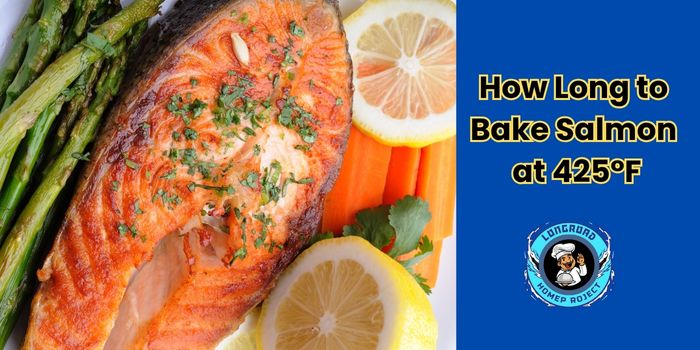
Bake Time Variations Based on How You Cook It
Cooking salmon at 425°F is quick and straightforward, but the exact bake time changes depending on whether you use foil, keep the skin on, or go skinless. Here’s how to adjust for each method to get perfectly cooked salmon every time.
How Long to Bake Salmon at 425°F in Foil
Baking salmon in foil at 425°F generally takes 12 to 15 minutes depending on fillet thickness. Wrapping salmon in foil creates a mini steam chamber that traps moisture and infuses flavor, making it incredibly tender and juicy.
- The foil packet method is great if you want to add lemon slices, garlic, herbs, or a splash of white wine to your salmon without losing any aroma or moisture.
- Because the fish cooks in its own juices, there’s no risk of sticking to the pan.
- Simply place the salmon on a large sheet of foil, add your seasonings, seal the packet tightly, and bake.
This method is perfect for delicate fillets or anyone who prefers a super moist, almost poached texture with subtle crisping at the edges.
How Long to Bake Salmon at 425°F Without Foil
If you bake salmon without foil, plan for about 10 to 12 minutes at 425°F. You can either place the fillets directly on a lightly oiled baking sheet or use parchment paper for easier cleanup.
- Without the protective foil cover, the salmon surface will dry out a little more, so it’s important to avoid overcooking.
- To prevent dryness, consider brushing the salmon with olive oil or melted butter before baking.
- Keep an eye on the oven during the last few minutes—especially if your fillets are thin.
This method delivers a firmer texture with a lightly crisped top, ideal if you like your salmon with a bit more bite and browning.
How Long to Bake Salmon at 425°F With Skin
For salmon with skin on, baking at 425°F typically takes about 12 minutes. The skin acts as a natural barrier between the heat and the delicate flesh, helping to protect the fish from overcooking.
- Always place the salmon skin-side down on the baking sheet or foil. This not only helps keep the fillet moist but can also create a crispy skin if baked uncovered.
- The skin adds flavor and texture and makes the salmon easier to flip if you’re finishing it on the stovetop or under the broiler.
Baking salmon with skin is a favorite technique for those who enjoy a crispy edge and moist interior.
How Long to Bake Salmon at 425°F Without Skin
Skinless salmon cooks faster—expect 10 to 11 minutes at 425°F depending on thickness. Because the protective skin is removed, the flesh is more exposed and can dry out quickly if not monitored carefully.
- To keep skinless fillets juicy, try basting them with butter or olive oil halfway through baking.
- You can also loosely cover the salmon with foil during cooking to trap moisture without steaming it too much.
- Use a meat thermometer or check for flakiness often, especially with thinner fillets.
This approach is best for recipes where you want clean, skinless portions or plan to add a sauce afterward.
Adjusting your bake time and technique based on these factors will ensure your salmon comes out perfectly cooked—whether juicy and tender or with a crispy, flavorful crust.
What About Other Oven Temperatures?
When it comes to cooking the perfect salmon, knowing how long to bake salmon at 425°F is only part of the story. Temperature plays a huge role in texture, moisture, and flavor. So, what happens when you adjust the heat up or down? Let’s break down the most common oven temperatures and how they affect your salmon.
Overview of Cooking Times at Other Common Oven Temperatures
Here’s a quick guide to help you estimate the cooking time based on the oven temperature you’re using. These times assume an average salmon fillet that’s about 1-inch thick:
| Oven Temperature | Estimated Bake Time | Texture Result |
|---|---|---|
| 375°F (190°C) | 15–18 minutes | Tender, slightly juicy |
| 400°F (204°C) | 12–14 minutes | Flaky, balanced |
| 425°F (218°C) | 10–12 minutes | Crisp edges, moist |
| 450°F (232°C) | 8–10 minutes | Charred, drier edges |
Note: Always check for doneness using a meat thermometer. Salmon is perfectly cooked at 125°F–130°F for medium and 135°F for well done.
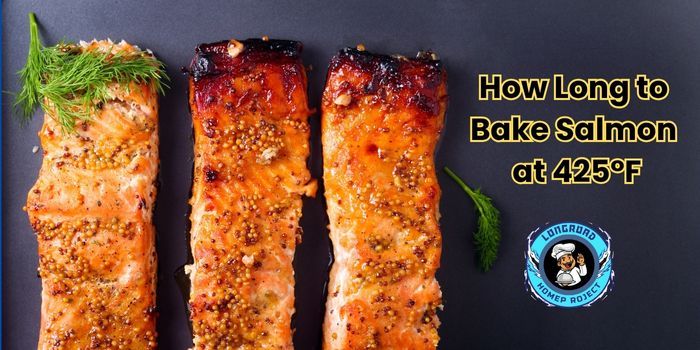
180°C / 200°C – What About Metric Temperatures?
For readers outside the U.S. (hello UK, Australia, and beyond!), your ovens likely use Celsius.
- 180°C (≈ 356°F): Bake for about 18–20 minutes
- 200°C (≈ 392°F): Bake for around 13–15 minutes
If you’re used to fan-forced or convection ovens, reduce the temperature by 20°C and check salmon early to avoid overcooking. These settings create a gentler heat, allowing the fish to cook more evenly without drying out.
Pros and Cons of Each Oven Temperature
Choosing the right temperature depends on your time, texture preference, and even your pan.
375°F (15–18 mins)
Pros:
- Gentle heat keeps salmon tender and juicy
- Great for thicker fillets or whole sides
Cons:
- Takes longer
- No crisp on the edges
400°F (12–14 mins)
Pros:
- Balanced cook time
- Still retains moisture
Cons:
- May not give crispy skin unless broiled briefly
425°F (10–12 mins)
Pros:
- Fast and flavorful
- Crisp edges with juicy interior
Cons:
- Can dry out thinner cuts if overbaked
450°F (8–10 mins)
Pros:
- Charred exterior for bolder flavor
- Ideal for caramelized glazes
Cons:
- Easy to overcook
- Less margin for error
So, Which Temperature Is Best?
425°F is the sweet spot for most home cooks. It’s hot enough to caramelize the exterior for a delicious crust, yet still gentle enough to preserve moisture inside. It’s especially ideal if you like your salmon with a crisp edge and a tender, flaky center — ready in just 10–12 minutes.
For busy weeknights, flavor-packed dinners, or when you’re baking with foil or seasoning rubs, 425°F gives you the best of both speed and taste.
Want to dive deeper? Up next, we’ll explore exactly how long to bake salmon at 425°F, including variations like skin-on vs. skinless, foil vs. no foil, and even oven hacks for perfect doneness.
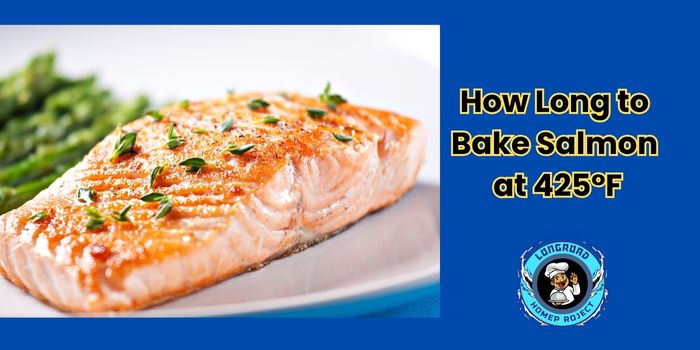
Tips for Perfect Baked Salmon Every Time
Getting salmon just right isn’t just about asking how long to bake salmon at 425°F — it’s also about how you prep, monitor, and finish the fish. Here are four pro-level (but super simple!) tips that will upgrade your salmon game every time, no matter what oven temp you choose.
Let Salmon Come to Room Temp First
It might seem small, but this step makes a huge difference. If you pop cold salmon straight from the fridge into the oven, the outside cooks faster than the inside, leading to uneven texture and overdone edges.
Let your salmon sit at room temperature for 15–20 minutes before baking. This helps the heat distribute evenly and leads to a more consistent, restaurant-quality finish.
Bonus Tip: If your kitchen is cold, cover the salmon loosely with foil during the resting period to prevent chilling.
Pat Dry and Season Well
Crispy skin starts with dry skin.
Before seasoning, use a paper towel to gently pat the salmon dry. This removes excess moisture, which helps the fish sear instead of steam. Whether you’re baking at 425°F or lower, this one step helps develop a beautiful golden crust.
Once dry, don’t skimp on seasoning. At minimum, go with:
- Sea salt
- Freshly cracked black pepper
- Olive oil or melted butter
For bonus flavor, consider:
- Lemon zest + fresh dill
- Garlic powder + paprika
- Brown sugar + soy glaze for a sweet-savory twist
Season both sides — even if you’re not eating the skin. Flavor seeps in from all directions.
Don’t Overcook
This is the most common salmon mistake. Even one or two extra minutes can mean the difference between moist, flaky fish and dry, chalky disappointment.
Use a digital meat thermometer and remove the salmon from the oven when the thickest part reaches 125°F. That’s the sweet spot for medium — tender, juicy, and slightly translucent in the center.
Remember, the salmon keeps cooking from residual heat once it’s out of the oven. This is called carryover cooking, and it brings the internal temperature up another 5–10°F while it rests.
“If you wait until it looks done, it’s already overdone.” — Every good chef ever
Let It Rest After Baking
The final secret? Let it rest.
Once your salmon is out of the oven, wait 5 minutes before cutting or serving. This pause gives the juices time to redistribute, which means a more flavorful and tender texture in every bite.
If you skip this step, the juices can leak out the moment you cut in, leaving you with dry fish and a messy plate.
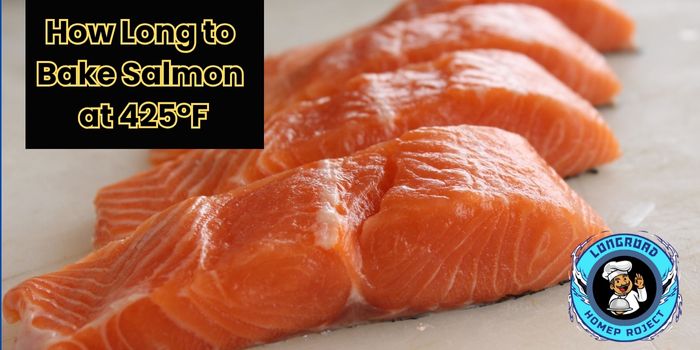
Frequently Asked Questions (FAQs)
How long do you cook salmon at 425?
✅ About 10 to 12 minutes, depending on the thickness of the fillet. For best results, use a digital thermometer and remove it from the oven when the internal temperature reaches 125°F.
Is 400 or 425 better for salmon?
✅ Both temperatures work well, but 425°F cooks faster and gives the salmon crispy edges. 400°F is better for thicker fillets or when you want a more gentle cook with less risk of drying out.
How long to cook salmon in oven at 200?
✅ At 200°F, salmon takes around 25 to 30 minutes to fully bake. It cooks very gently, resulting in a soft, moist texture, but won’t develop a crispy exterior.
How long to bake salmon at 425 in foil?
✅ Bake for 12 to 15 minutes at 425°F. Wrapping the salmon in foil helps trap moisture and flavors, making it ideal for garlic butter, lemon, or herb-infused recipes.
How long to bake salmon at 425 without foil?
✅ 10 to 12 minutes is typically perfect. Without foil, be sure to lightly oil the pan or use parchment paper to prevent sticking and enhance browning.
How long to bake salmon at 425 with skin?
✅ Around 12 minutes, skin-side down. The skin helps protect the flesh from overcooking and can crisp up beautifully if placed directly on a hot pan or baking sheet.
How long to bake salmon at 425 without skin?
✅ About 10 to 11 minutes. Skinless salmon cooks faster and may dry out more easily, so consider adding a drizzle of olive oil, lemon juice, or butter to keep it moist and flavorful.
Conclusion
So, how long bake salmon at 425°F? The answer is clear: 10 to 12 minutes is that golden window where flavor, texture, and ease come together perfectly. But time alone isn’t enough. The real key to delicious, never-dry salmon is checking the internal temperature — aim for 125°F and let it rest for a few minutes to finish cooking gently.
Don’t be afraid to play around with technique, either. Whether you’re baking with foil for moisture, going skin-on for crispness, or trying out new seasoning blends, salmon is one of the most forgiving and flavorful proteins you can cook. A few tweaks can turn a good dish into an unforgettable one.
Next time you’re cooking salmon, try it at 425°F and let us know how it turns out! We’d love to hear your favorite combos — lemon and dill, honey garlic, Cajun rub, you name it.
Now you’re armed with the tips, timing, and tools to nail it every time. Happy baking!
As an Amazon Associate I earn from qualifying purchases.
